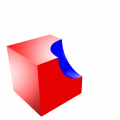Constructive solid geometry
|
|
Constructive solid geometry (CSG) is a branch of solid modelling that deals with representations of a solid object as a combination of simpler solid objects. It is a procedural modelling technique used in 3D computer graphics and CAD.
The simplest solid objects used for the representation are called primitives. Typically they are the objects of simple shape: cuboids, cylinders, prisms, pyramids, spheres, cones. The set of allowable primitives may be restricted; e.g., curved shapes may be forbidden.
It is said that an object is constructed from primitives by means of allowable operations, which are typically Boolean operations on sets: union, intersection and difference.
Operations
In modelling packages, basic geometric objects such as the cube or 'boxes', spheres or ellipse, torus, and a number of other shapes that can be described using a mathematical formula, are commonly known as primitives. These objects can typically be described by a procedure which accepts some number of parameters; for example, a sphere may be described by the coordinates of its center point, along with a radius value. These primitives can be combined into compound objects using operations like these:
Applications of CSG
Constructive solid geometry has a number of practical uses. It is used in cases where simple geometric objects are desired, or where mathematical accuracy is important. The "Unreal" game engine uses this system, as do Hammer (the mapping engine for the Source game engine) and Quake. (Hammer actually started out as an editor for Quake.) BRL-CAD is a Solid_modeling CAD package that is fundamentally based on CSG modeling techniques.nl:Constructieve lichaamgeometrie


